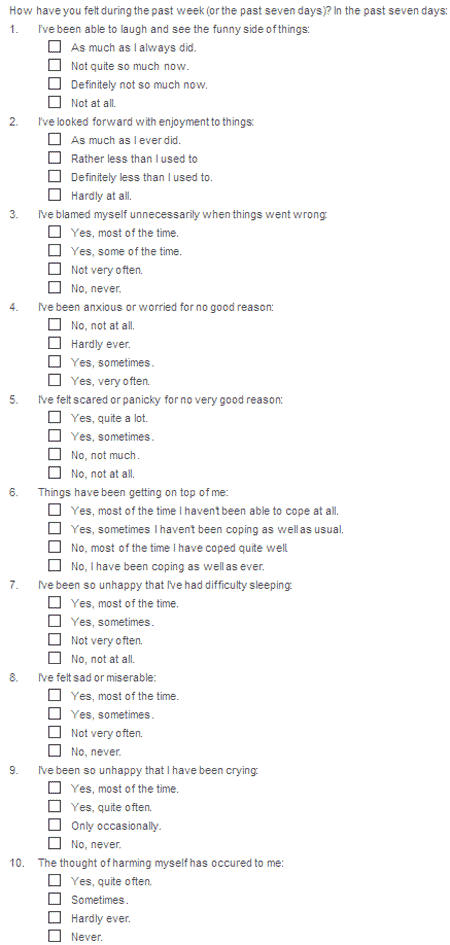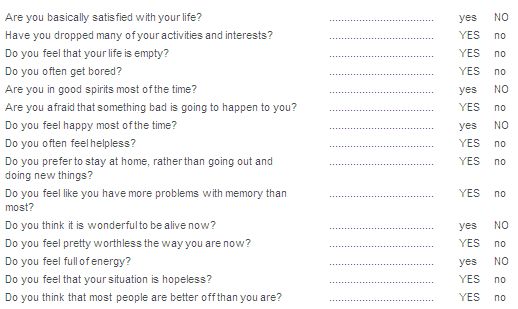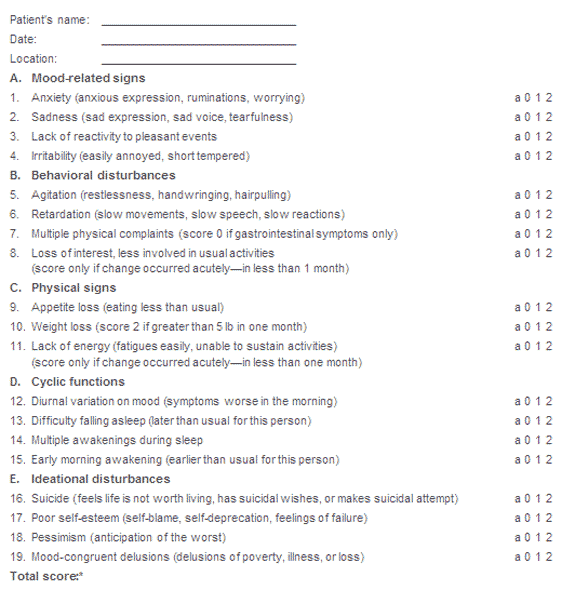
Am Fam Physician. 2002;66(6):1001-1009
A more recent article on depression screening and diagnosis is available.
Depression is a common psychiatric disorder in children, adolescents, adults, and the elderly. Primary care physicians, not mental health professionals, treat the majority of patients with symptoms of depression. Persons who are depressed have feelings of sadness, loneliness, irritability, worthlessness, hopelessness, agitation, and guilt that may be accompanied by an array of physical symptoms. A diagnosis of major depression requires that symptoms be present for two weeks or longer. Identifying patients with depression can be difficult in busy primary care settings where time is limited, but certain depression screening measures may help physicians diagnose the disorder. Patients who score above the predetermined cut-off levels on the screening measures should be interviewed more specifically for a diagnosis of a depressive disorder and treated within the primary care physician's scope of practice or referred to a mental health subspecialist as clinically indicated. Targeted screening in high-risk patients such as those with chronic diseases, pain, unexplained symptoms, stressful home environments, or social isolation, and those who are postnatal or elderly may provide an alternative approach to identifying patients with depression.
Depression is the second most common chronic disorder seen by primary care physicians.1 On average, 12 percent of patients seen in primary care settings have major depression.2 The degrees of suffering and disability associated with depression are comparable to those in most chronic medical conditions.3 Fortunately, early identification and proper treatment significantly decrease the negative impact of depression in most patients.4 Most patients with depression can be effectively treated with pharmacotherapeutic and psychotherapeutic modalities.5
Depression occurs in children, adolescents, adults, and the elderly. It manifests as a combination of feelings of sadness, loneliness, irritability, worthlessness, hopelessness, agitation, and guilt, accompanied by an array of physical symptoms (Table 1).6 Recognizing depression in patients in a primary care setting may be particularly challenging because patients, especially men, rarely spontaneously describe emotional difficulties. To the contrary, patients with depression who present to a primary care physician often describe somatic symptoms such as fatigue, sleep problems, pain, loss of interest in sexual activity, or multiple, persistent vague symptoms.7
Screening for Depression
The U.S. Preventive Services Task Force (USPSTF) recently reviewed new evidence finding that patients fared best when physicians recognized the symptoms of depression and made sure that they received appropriate treatment.8 Based on this evidence, the USPSTF issued new depression screening recommendations last May, encouraging primary care physicians to routinely screen their adult patients for depression. Physicians should have systems in place to assure accurate diagnosis, effective treatment, and follow-up if patients are to benefit from screening.
There was insufficient evidence for the USPSTF to recommend for or against routine screening of children and adolescents, although physicians should remain alert for signs of depression in younger patients.
Numerous screening measures have been specifically designed to detect depression. Physicians can choose the screening measures that are appropriate for their patients and practice setting, and for monitoring change in patients who are receiving treatment for depression.9
Self-reporting measures can be quickly completed and scored, although other time-intensive, interviewer-administered measures may be necessary when patients are cognitively impaired.
According to the USPSTF,8 an affirmative response to the following two questions may be as effective as using longer screening measures or may indicate the need for the use of more in-depth diagnostic tools: (1) “Over the past two weeks, have you ever felt down, depressed, or hopeless?” and (2) “Have you felt little interest or pleasure in doing things?”
Selection of a screening measure, whether it be the two simple questions above or a longer diagnostic tool, is the first and most important step in the process of managing depression. Considerations for selecting a measure include characteristics of the population to be screened, psychometric properties of the instrument, time required to complete the measure, time required to score the measure, ease of use, and cost of obtaining the measure.
Depression Screening Measures
Depression screening measures do not diagnose depression, but they provide an indication of the severity of symptoms and assess the severity within a given period of time (e.g., the past seven to 14 days). Although each measure has a unique scoring system, higher scores consistently reflect more severe symptoms. All measures have a statistically predetermined cutoff score at which depression symptoms are considered significant. Some measures group scores into different levels of symptom severity.
Persons scoring above the established cutoff level should be interviewed to assess for the depressive disorders criteria found in the Diagnostic and Statistical Manual of Mental Disorders, 4th Edition, Text Revision (DSM-IV-TR).6 These include major depressive disorder, subclinical or minor depression, and dysthymia. An interview is necessary because many conditions have symptoms that are common to depression. In addition, screening measures do not address important diagnostic features such as duration of symptoms, degree of impairment, and comorbid psychiatric disorders. An evaluation is critical in ruling out conditions that may present with symptoms of depression, such as hypothyroidism and pancreatic cancer. Finally, clinical judgment should supersede strict adherence to DSM-IV-TR criteria because the clinical manifestations of depression may vary by age, gender, or cultural background.
DEPRESSION IN CHILDREN, ADOLESCENTS, AND YOUNG ADULTS
Depression in children and adolescents is associated with an increased risk of illness along with interpersonal and psychosocial difficulties that can persist long after the depressive episode is resolved.10,11 In adolescents, depression is associated with an increased risk of substance abuse and suicidal behavior.10 Diagnosing depression in children is particularly difficult because limited language abilities make it necessary to integrate information from multiple sources (e.g., a parent, a teacher, another child). Depression appears to be rare in children younger than six years. Approximately 2 percent of elementary-school-aged children experience depression.10 Rates of depression dramatically increase during adolescence, and up to 8 percent of U.S. teenagers are affected.10
Depression screening measures for children and adolescents (Table 2)12–24 are generally appropriate in children who are at least seven years of age with a sixth-grade reading level or higher. However, the Reynolds Child Depression Scale12 (available for purchase atwww.parinc.com/index.cfm) and the Children's Depression Inventory14 (available for purchase atwww.mhs.com) were developed specifically for children and are written at lower reading levels.
The Reynolds Adolescent Depression Scale13 (RADS; available for purchase atwww.parinc.com/index.cfm) is one of a few depression screening measures developed specifically for adolescents; however, no Spanish version is commercially available. The Center for Epidemiologic Studies Depression Scale for Children (CES-DC),15 the Center for Epidemiologic Studies Depression Scale (CES-D),16 the Beck Depression Inventory (BDI),17 and the Children's Depression Inventory (CDI) are alternatives for use in adolescents. Advantages of the BDI and CES-D include ease of scoring, low cost, and comparable psychometric properties.
The screening measures for children and adolescents listed in Table 2 have been primarily used for research, and their clinical use in screening children and adolescents in primary care settings has not been established. Until further research is conducted, these measures should be used in young patients only when there is a high index of suspicion for depression and should not be used as a routine screen for depression.25 The measures may also be used to monitor treatment response in patients who have been diagnosed with depression.
| Measure | Age appropriateness (approximate years) | Reading level (grade) | Spanish version | Number of items | Time to complete (approximate minutes) |
|---|---|---|---|---|---|
| Children and adolescents | |||||
| Children's Depression Inventory (CDI)14 | 7 to 17 | 1st | Yes | 27 | 10 to 15 |
| Center for Epidemiological Studies-Depression Scale for Children (CES-DC)15 | 12 to 18 | 6th | Yes | 20 | 5 to 10 |
| Center for Epidemiological Studies-Depression Scale (CES-D)16 | 14 and older | 6th | No | 5 to 10 | |
| Reynolds Child Depression Scale12 | 8 to 12 | 2nd | Yes | 30 | 10 to 15 |
| Reynolds Adolescent Depression Scale13 | 13 to 18 | 3rd | No | 30 | 10 to 15 |
| Beck Depression Inventory (BDI)17 | 14 and older | 6th | Yes | 21 | 5 to 10 |
| Adults | |||||
| Beck Depression Inventory (BDI)17 | Yes | 21 | 5 to 10 | ||
| Beck Depression Inventory-II18 | Yes | 21 | 5 to 10 | ||
| Beck Depression Inventory-PC (BDI-PC)19 | Yes | 7 | Fewer than 5 | ||
| Center for Epidemiological Studies Depression (CES-D)16 | Yes | 20 | 5 to 10 | ||
| Edinburgh Postnatal Depression Scale21 | Yes | 10 | Fewer than 5 | ||
| Zung Depression Rating Scale20 | No | 20 | 5 to 10 | ||
| Elderly | |||||
| Beck Depression Inventory (BDI)17 | Yes | 21 | 5 to 10 | ||
| Center for Epidemiological Studies Depression Scale (CES-D)16 | Yes | 20 | 5 to 10 | ||
| Cornell Scale for Depression in Dementia24 | No | 19 | 10 with patient, 20 with caregiver | ||
| Geriatric Depression Scale (GDS)22 | Yes | 30 | 10 to 15 | ||
| Geriatric Depression Scale-short23 | Yes | 15 | 5 to 10 | ||
| Zung Depression Rating Scale20 | No | 20 | 5 to 10 | ||
The Pediatric Symptom Checklist is an alternative tool for screening pediatric patients for psychosocial problems.26 Although the Pediatric Symptom Checklist is not specific for depression, its 35-item checklist is designed for parents to complete and may help identify young patients in need of further assessment.
DEPRESSION IN ADULTS
The lifetime prevalence of major depression in adults is estimated to be 7 to 12 percent in men and 20 to 25 percent in women.27 The prevalence of depression in patients in primary care settings ranges from 5 to 10 percent.28 The rates are significantly higher in persons with certain medical conditions, including obesity, diabetes mellitus, cancer, and a history of myocardial infarction.29–31
Common depression screening measures for adults are shown in Table 2. The most commonly used screening measures for adults in ambulatory medical settings include the Beck Depression Inventory Scales (BDI-II18 [which replaced BD-I], and BDI-PC19; available for purchase atwww.psychcorp.com), the Center for Epidemiologic Studies Depression Scale, Revised (CES-DR),16 and the Zung Self-Rating Depression Scale.20 These measures take approximately five to 10 minutes for patients to complete, except for the BDI-PC (Figure 1),19 which takes only two to three minutes. Questions are posed within slightly different time frames. The BDI refers to “today,” the CES-DR refers to “in the past week,” and the Zung refers to “the past several days.” Scoring of the BDI and CES-DR measures is completed by totaling the numbers next to each response. Scoring of the Zung scale is slightly more difficult because the raw score must be converted using a table.
The BDI-II (available for purchase atwww.psychcorp.com) is the current version of the original BDI that was modified to reflect DSM-IV criteria. The BDI-PC is a seven-item version of the BDI-II. Both versions frame questions within “the past two weeks, including today.” In settings where burden to the patient and time are considerations, the seven-item BDI-PC may be advantageous to use because it is faster to administer and score; however, its sensitivity and specificity are slightly lower than the longer version.
The Primary Care Evaluation of Mental Disorders (PRIME-MD) Patient Health Questionnaire32 is not included in this review because it assesses for several common mental disorders. However, the nine items in the questionnaire that assess depression can be extracted and used in isolation.
POSTPARTUM DEPRESSION
The BDI, CES-D, and Edinburgh Postnatal Depression Scale (Figure 2)21 have been used to screen for depression in women during the antepartum and postpartum periods. Notably, the BDI and CES-D tend to produce higher scores and more false-positive results in symptomatic pregnant women.36–38 Alternatively the Edinburgh Postnatal Depression Scale was specifically developed for assessing postpartum depression and relies much less on somatic questions. Questions on the Edinburgh scale are framed within the “past seven days” and the response format is frequency-based. The responses to the 10 items are added together to obtain a score. Routine use of the Edinburgh Postnatal Depression Scale during the postpartum period has been shown to increase the detection of postpartum depression compared with usual care.39

DEPRESSION IN THE ELDERLY
The prevalence of depression in adults older than 65 years of age ranges from 7 to 36 percent in medical outpatients and increases to 40 percent in hospitalized elderly patients.40,41 Up to 50 percent of patients with Alzheimer's disease or Parkinson's disease develop a depressive disorder, and their caretakers—no matter what their age—are also at an increased risk. Signs of depression that are more common in the elderly than in other populations include diminished self-care, irritability, and psychomotor retardation. Early diagnosis and treatment of depression in the elderly improve quality of life and functional status, and may help prevent premature death.
When using screening instruments with elderly patients, it is important to consider their level of cognitive impairment along with visual deficits. The validity of certain depression screening instruments is significantly decreased in patients with a Mini-Mental State Examination score of 15 or less.42 Table 2 includes information on the BDI, CES-D, and Geriatric Depression Scale (GDS)22 specific to their use in persons older than 60 years. The GDS is unique in that it was specifically developed for use in geriatric patients, and it contains fewer somatic items. Recently, a 15-item short form of the GDS was validated (Figure 3).23 Both formats frame questions within the past week and responses require only a “yes” or “no,” making comprehension easier compared with the instruments that present four-choice answers.
| Adults | Children and adolescents |
| First-degree biologic relative with history of depression | Antisocial behavior |
| Diminished school performance | |
| Two or more chronic diseases | Withdrawal from friends or social activities |
| Obesity | |
| Chronic pain (e.g., backache, headache) | Excessive weight gain or loss |
| Impoverished home environment | Substance abuse, such as alcohol or street drugs |
| Financial strain | |
| Experiencing major life changes | Aggression |
| Pregnant or postpartum | Agitation or irritability |
| Socially isolated | |
| Multiple vague symptoms (e.g., gastrointestinal, cardiovascular, neurologic) | |
| Fatigue or sleep disturbance | |
| Substance abuse, such as alcohol or street drugs | |
| Loss of interest in sexual activity | |
| Elderly age |

A one-item screening question, “Do you often feel sad or depressed?” may screen as effectively as the GDS and save time.43 Other alternatives for geriatric patients include the BDI and CES-D. In cognitively intact patients older than 65 years, the GDS or one-item screen are currently the preferred instrument because the psychometric data on the BDI and CES-D are mixed in this population.44
In patients who have cognitive deficits, interviewer-administered instruments such as the Cornell Scale for Depression in Dementia (Figure 4)24 or the Hamilton Rating Scale for Depression45 are preferred. These instruments require more time to administer; however, they are more appropriate than self-report instruments for cognitively impaired patients. The Cornell measure should be administered to the patient's primary caregiver.

Final Comment
The use of longer depression screening measures is most appropriate in targeted adult patient populations at high risk for depression, with the shorter measures being used for general screening of the adult population. Indications for screening for depression are summarized in Table 3. Once depression is diagnosed and treatment is initiated, repeated administration of these measures provides an excellent means of tracking response to pharmacotherapy or psychotherapy.
Depression measures should be selected based on the patient population (Table 4). The Pediatric Symptom Checklist may serve as a general psychosocial screen for children and adolescents. In adult patient populations, screening with the BDI, CES-D, or Zung measures is recommended in targeted, high-risk populations. In postpartum women, the Edinburgh Postnatal Depression Scale is the preferred measure.
The use of depression screening measures in elderly patients varies with their cognitive status and clinical presentation. Use of the GDS is limited to cognitively intact or mildly impaired elderly patients and interviewer-administered instruments, such as the Cornell Scale for Depression in Dementia or the Hamilton Rating Scale, are preferable when cognitive deficits are present. However, older patients with depression may also present with unexplained somatic symptoms and may deny sadness or loss of pleasure. Consequently, clinical judgment may be more helpful than screening measures.
| Population | Screening instrument | |
|---|---|---|
| Children | Pediatric Symptom Checklist28 (not depression-specific) | |
| Adults | Center for Epidemiological Studies-Depression Revised (CES-DR) | |
| Beck Depression Inventory-Primary Care (BDI-PC)19 | ||
| Peripartum women | Edinburgh Postnatal Depression Scale21 | |
| Elderly | Geriatric Depression Scale22,23 | |
| Cornell Scale for Depression in Dementia24 | ||